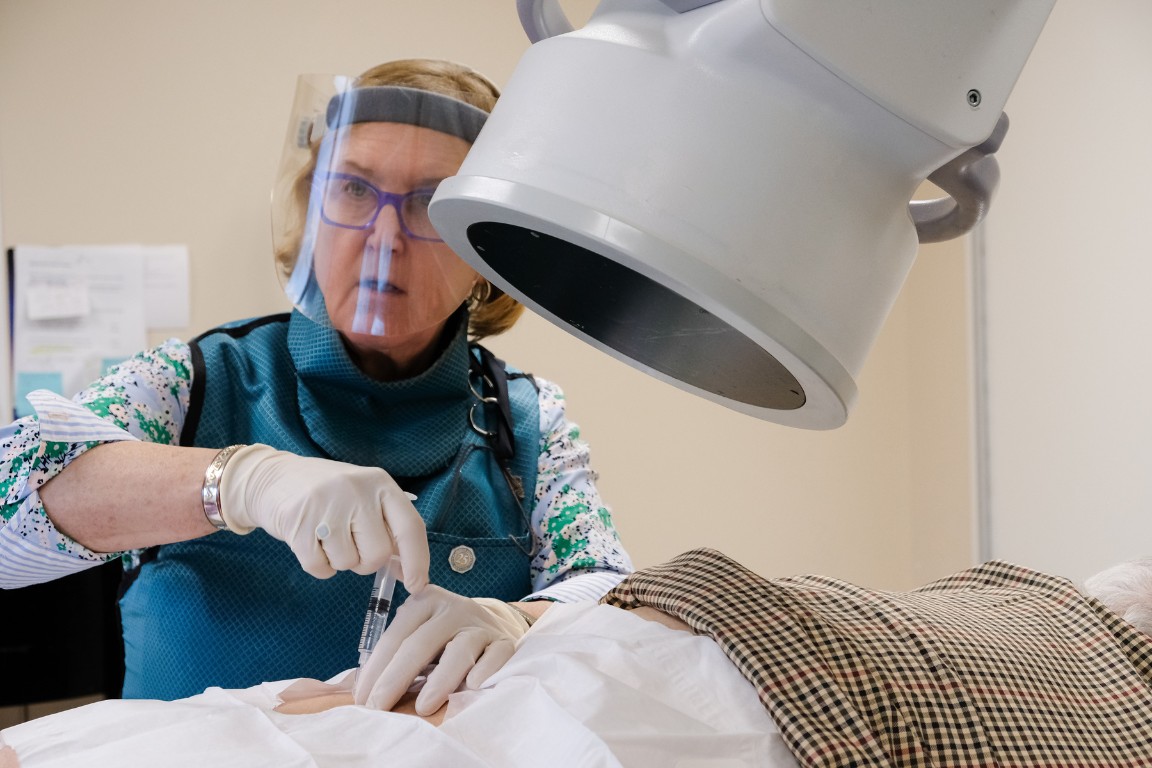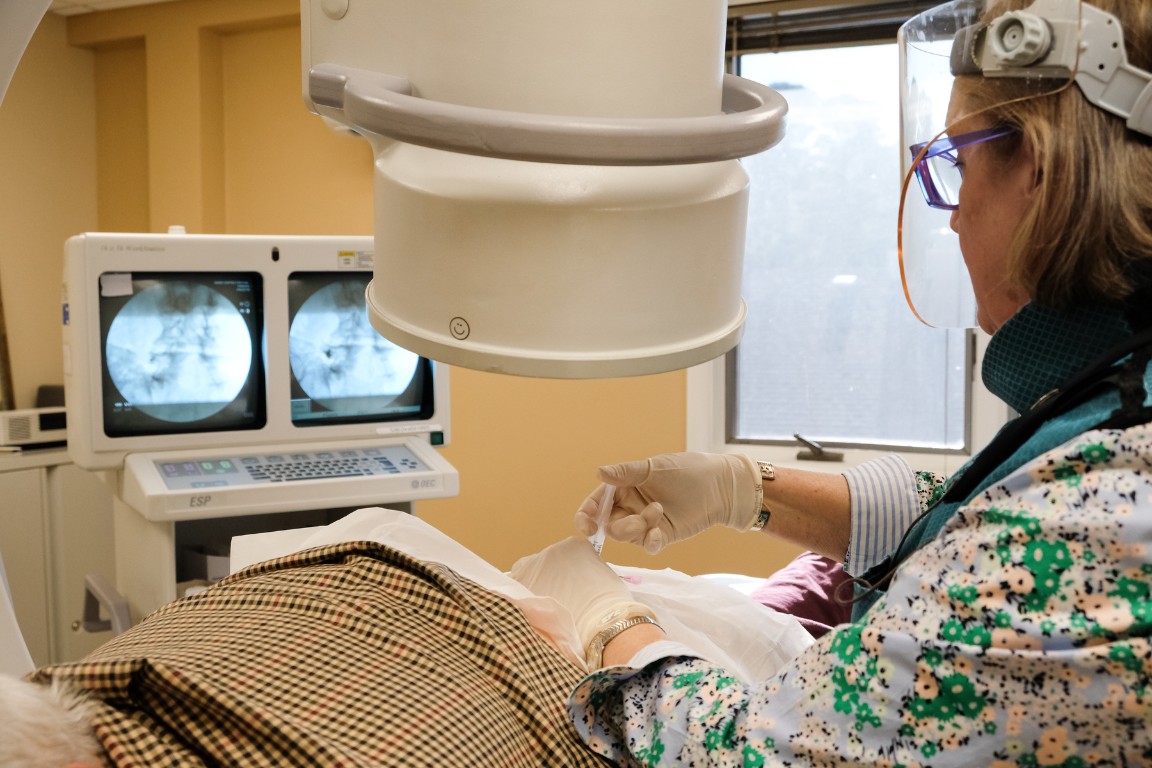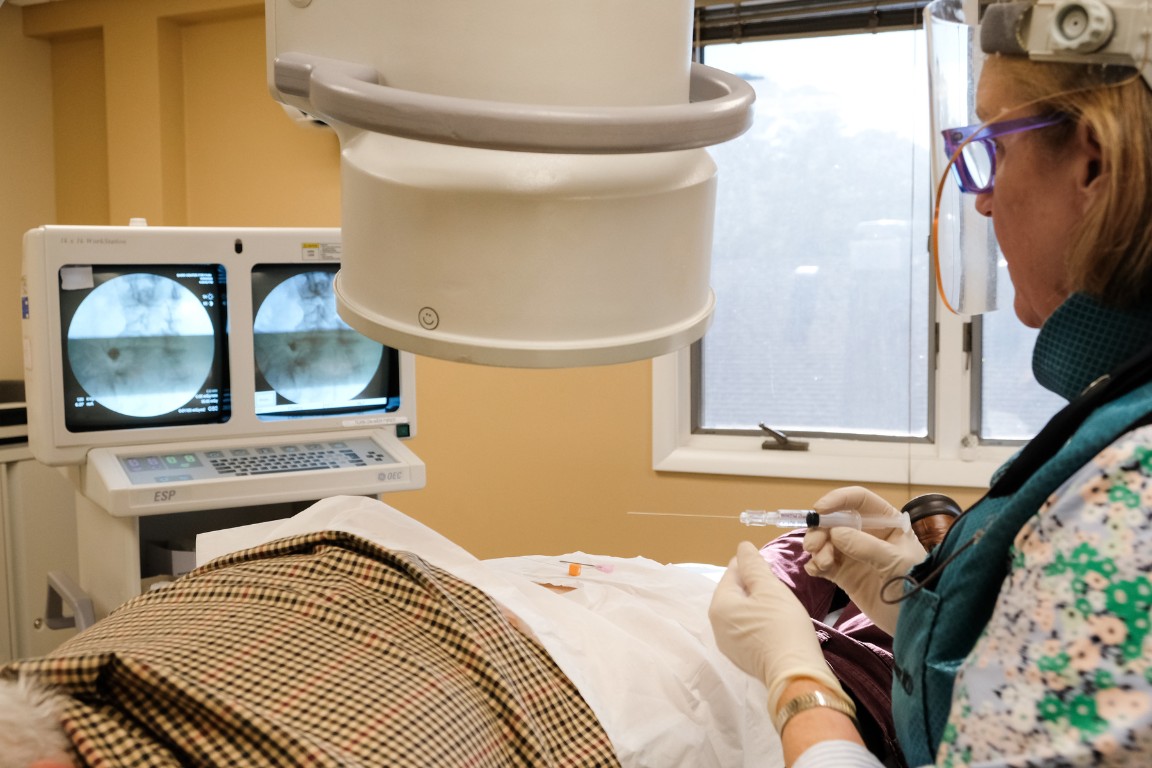Back Pain Relief
 At the Barr Center, our approach to low back pain relief begins and ends with our patients.
At the Barr Center, our approach to low back pain relief begins and ends with our patients.
Because the low back supports the entire weight of our body and is responsible for our ability to move and resist gravity it takes a lot of wear and tear throughout our life. Low back pain can significantly inhibit your ability to perform simple day-to-day activities like walking, standing, getting in and out of a car and can significantly impact our sleep quality.
Severe low back pain is the most common cause of disability. Patients who visit the Barr Center for low back pain relief often are unable to lead the active lifestyles to which they are accustomed due to injury, overuse or the cumulative effects of aging.
Degenerative conditions of the spine are part of the aging process and do not always require interventional pain treatment or surgery. Sometimes the solution to pain from degenerative spinal conditions can be found with treatment of mechanical problems, changes in diet as well as posture and lifestyle changes. We can certainly help you sort this out and assist you in charting a quick and effective course of treatment- be it office based osteopathic manipulative therapies to physical therapy as well as sophisticated interventional x-ray guided injections and radiofrequency ablation procedures.
Back Pain Relief that Restores Your Healthy Lifestyle
Our treatments focus on restoring your ability to live a healthy, active lifestyle. This starts with identifying the sources of your pain. Treatment then starts with our initial focus on your unique back pain generators and expands to include compensatory issues that develop in response to your pain. This includes looking for ergonomic factors, leg length differences, gait and balance disturbances, core weakness, dysfunctional breathing patterns and training and exercise issues. We even look at your feet as this is where your back meets the ground and any issue within the kinetic chain, which starts in the foot can impact your back.
Low back pain problems often develop from everyday wear and tear, overuse, or an injury. They can also be caused by the natural process of aging. Pain may arise from the low back itself or from any of the many surrounding muscles, ligaments or tendons in the pelvis, hips and trunk. Low back pain that originates from the joints of the low back (arthritis of the lumbar spine) usually worsens with activities such as bending, standing and walking. Low back pain that is worse at night or is associated with fever or chills is potentially worrisome and should be immediately reported to your provider.
Degenerative lumbar spine issues particularly at L4-5 and L5-S1 levels can refer pain to the hip and knee making an accurate diagnosis sometimes tricky. Low back pain can also be attributed to dysfunction in the pelvis and sacroiliac joints. Pain felt in one area that arises from another structure is called referred pain. Referred pain is different than sciatica which is due to a pinched nerve usually caused by a herniated disc, bone spur or stenosis. There are also conditions within the abdomen that can cause low back pain such as diverticulitis, hernias, colitis, IBS and infections to name a few. Pain that arises from abdominal or pelvic issues is called visceral referred pain. Additionally, scar tissue from abdominal, pelvis and low back surgeries can cause restriction of movement and low back pain.
Back Pain Diagnosis
In your very first appointment at the Barr Center, we’ll ask you to localize and describe your low back pain, its history and what you think has contributed to its occurrence. A physical examination, x-rays and imaging studies will follow. MRI scans or cat scans may be necessary to clarify the root cause of your pain and help steer treatment in the right direction. Depending on your Insurance plan we may need to pursue 6 weeks of continuous treatment and order plain x-rays and document your response before an MRI will be authorized.
Understanding Low Back Pain
If you have low back pain you are not alone. The Centers for Disease Control estimates that 70-85% of all people will have back pain at some time during their lives. The most common complaint of pain, back pain affects more and more people every year. It is the fifth most common reason for all physician visits. Back pain is most frequently the cause of limited activity in people, particularly those under the age of 45. It is also a significant cause for loss of productivity at work, costing employers more than $62 billion per year, mostly related to reduced performance rather than loss of time.
Back pain may originate from the discs, joints, muscles, bones, nerves, ligaments or other structures in the spine.
Correlations of increased risk for low back pain have been found with
- Body mass index (BMI), mechanical loading, and genetic predisposition.
- Genes coding for collagen, proteins, vitamin D receptors, cartilage and inflammatory chemicals.
- Smoking and increased rates of disk degeneration, with animal models showing increased proinflammatory markers, alterations to annular structure, vasoconstriction, and altered nutrient distribution to the disc.
The spine is a network of nerves, discs, joints, muscles, tendons and ligaments, and all are capable of producing pain. Large nerves that originate in the spine supply the legs and arms and can cause pain to radiate to those extremities.
Anatomy Of The Spine
 The back is composed of vertebrae stacked on each other. There are seven cervical (neck) vertebrae, 12 thoracic (mid-back) vertebrae, five lumbar vertebra, the sacrum, and the coccyx. They are stacked in a way to form an S-shaped column and are supported by muscle and ligaments.
The back is composed of vertebrae stacked on each other. There are seven cervical (neck) vertebrae, 12 thoracic (mid-back) vertebrae, five lumbar vertebra, the sacrum, and the coccyx. They are stacked in a way to form an S-shaped column and are supported by muscle and ligaments.
The main function of the spine is to support the weight of the body and hold your head on straight while maintaining flexibility. Between each vertebra is an intervertebral disc which acts as a spacer and shock absorber. The discs and the vertebrae work together in a series of joints that allow the spine to move forward, back, and sideways and also allow for rotation.
The spine also protects the spinal cord. The spinal cord is a tube of nervous tissue that runs from the brain through the spinal column ending up as a series of nerves. These nerves leave the spinal column at different levels to supply the limbs, organs of the body, and sensation to the skin.
The degenerative cascade:
The back is designed to support muscles, ligaments and organs. Because of our varied postures (sitting, standing, bending) and activities, the spine is subjected to numerous stressors during the day. It can cope with everyday stresses such as lifting, but when your spine is subjected to abnormally high stress, the muscles and ligaments become overstretched and tear. The discs start to deteriorate and the joint spaces start to decrease, causing joint damage that can lead to nerve compression. As we age, the discs in our back start to shrink and lose their elasticity. This progresses to degenerative disc disease.
Resources on the Academy of Physical Medicine and Rehabilitation website states that The Kirkaldy-Willis degenerative spine cascade is the most accepted theory on events that ultimately lead degenerative conditions of the lumbar spine including the development of spondylosis and stenosis. The theory highlights the interaction between the facet joints and the discs in establishing a 3-joint complex that undergoes 3 phases of degeneration. Phase 1, the dysfunctional phase, involves development of annular fissures, tears and repetitive microtrauma of the discs, which predisposes the disc to herniation and impacts its ability to retain water, leading to a loss of disc height. Phase 2, the instability phase, involves disc resorption, internal disc disruption, and additional tears, causing loss of mechanical integrity of the 3-joint complex. Phase 3, the stabilization phase, involves further disc space narrowing, fibrosis, and bone spur formation. Depending on where you are in the degenerative cascade will largely determine how we will treat you.
Adapted from the AAPM and R website Author(s): Thiru M. Annaswamy, MD and Charles Taylor, II MD, PhD
Originally published:09/20/2013 Last updated:08/18/2017
Who is most affected by back pain?
Back pain is most common in adults, and more prevalent in men than in women. However, with children carrying heavier backpacks for school and being more sedentary in their activities, back pain is becoming more common in young people. People who sit for prolonged periods and those who operate vibratory equipment or drive for prolonged periods are also at increased risk of disc disease. In fact the American Medical Association has stated that sitting is more dangerous to our overall health than smoking.
What causes back pain?
Back pain may be the result of an acute onset (sudden trauma) or chronic (long-term) in nature, and can include:
- Traumatic injury
- Repetitive stresses
- Disc deterioration/degeneration
- Arthritis
- Poor posture
- Genetics
What are the characteristics of back pain?
The nature of your pain can be:
- Constant or intermittent
- Localized or refer and/or radiate to other areas
- A dull ache or a sharp, piercing or burning sensation
- Low back (may radiate into the leg or foot)
- Symptoms other than pain, such as weakness, numbness, or tingling
How is back pain diagnosed?
In diagnosing the cause of your back pain, it is important to review the history of your symptoms and injury. Your evaluation will also include an assessment of:
- The location, intensity, duration, and radiation of the pain into your buttock or leg
- Pain with coughing or sneezing
- Pain at night
- Any past injury to the back
- What positions or motions aggravate and/or relieve your pain
- Range of motion limitations and shifts in your standing posture
- Tenderness and soft tissue restrictions
Further testing of undiagnosed back pain can include:
- X-ray evaluation
- CT scan, bone scan
- MRI
- Myelogram
- Electromyography (EMG) and nerve conduction studies
- Epidural steroid injections
- Nerve blocks
- Discograms
Back Pain Treatment
Most back pain will usually improve within a few weeks without medical intervention. Pain relievers, moist heat and/or ice may be all that you need to reduce or eliminate your pain. Bed rest typically does more harm than good. Excessive use of pain relievers may also not be in your best interest as inflammation is part of the healing process.
If home treatments are not working for you, your doctor may suggest stronger medications or other therapy. It should be noted that the focus of treatment at The Barr Center is on restoring function and management without reliance on medications. Your treatment for back pain will be determined based on your symptoms and treatment history and may include any of the following:
Medications
- Acute pain
- Analgesics
- Muscle relaxers
- Chronic Pain
- Antidepressant medications. Low doses of antidepressant medications have been found to have a positive effect on pain. The use of these medications is for pain medication, not depression.
- Narcotics (opioids). These medications, such as codeine or hydrocodone, may be used for a short period of time with close supervision by your doctor.
- Topical creams
- Pain patches
Physical Therapy
- Modalities to reduce pain, such as moist heat, ultrasound, massage, traction
- Manual techniques and dry needling to release trigger points and restore muscle balance
- Strengthening, stabilization and flexibility exercises to restore function and strength
- Education to prevent further injury or recurrence of pain
- McKenzie exercises
Procedures to Reduce Pain
- Electrical stimulation
- TENS (Transcutaneous Electrical Nerve Stimulation)
- Home muscle stimulation units
- Epidural steroid injections
- Proliferative therapy
- Autologous platelet-rich plasma injection
- Facet injections
- Nerve blocks
- Radiofrequency denervation
Surgery performed by spine surgeons include:
- Laminectomy
- This procedure involves removing part of your vertebra called the lamina. That opens up the spinal canal space and reduces pressure on your spinal nerves. It can decrease and/or relieve extremity pain caused by bone spurs or disc fragments that may be causing pressure on your spinal cord or nerve roots.
- Fusion
- This surgery involves joining two or more vertebrae. It is used primarily to eliminate pain caused by abnormal motion of the vertebrae or to remove or immobilize a painful disc segment by immobilizing the vertebrae themselves. A discogram may be performed in order to determine exactly which disc(s) is causing the pain and therefore determine the level or levels to be fused.
- Discectomy
- This is a surgical procedure in which a segment of the intervertebral disc that is causing pressure on the spinal nerves is removed.
How can I prevent back pain?
Back pain can be prevented by the following:
- Regular exercise
- Exercise regularly to improve posture and strengthen the back muscles for increased support of the spine.
- Learn how to stabilize your core muscles, as this will stabilize the spine during all activities.
- Maintaining good dietary habits
- Using good body mechanics when lifting or carrying
- Practice proper lifting and carrying techniques when lifting, squatting, bending
- Picking up a load – squat down and hold the object as close to the body as practical and lift using the legs, keeping your back straight.
- For heavy loads – get help or use a cart to avoid injury to your back.
- Having good sitting posture (avoid slouching)
- When driving or sitting for long periods of time, use a lumbar support to maintain the lumbar curve. If your legs are too short, use a footrest.
Back pain in children can be reduced by:
- Using book bags properly
- Do not overload
- Make sure that the book bag does not weigh more than 10 percent of your child’s weight.
- Pack Properly
- Pack the heaviest items so that they are closest to the child’s back, and so that the items cannot move around as they travel.
- Use both straps
- Packs should be carried with a strap over each shoulder, not just on one shoulder.
- Use framed backpacks
- The pack should have a molded frame and/or adjustable hip strap so that the weight of the filled backpack will rest on the pelvis instead of being distributed over the shoulders and spine.
- Exercising regularly
- Learn to properly stretch, especially during growth spurts when bones lengthen faster than muscles and posture changes.
- Learning good dietary habits
Can the Barr Center Help You with Back Pain Relief?
Call us at 757-578-2260 or email us at Info@BarrCenter.com to get started on relieving your back pain. To learn more about the anatomy of the back and the causes of back pain, visit our blog articles below for more information.
Learn More
Other pain management conditions we treat are: Neck Pain, Shoulder Pain, Hip Pain and Knee Pain. We often use Regenerative Medicine, and sometimes combine physical therapy, in our pain management treatments.

Experiencing Pain?
Reach Out To Us About Medication-Free Treatment
“I came in bent over and could barely move because of my back spasms.
I was given an injection in my back and it was like a miracle.
It is still doing great 6 months later. Now I am being seen for my knee and my shoulder”
Patient
Related Articles
Outsmart Your Pain!
by Lisa Barr, M.D.
The Essential Guide to Overcoming Pain and Transforming Your Life.
Learn how to kick the pain habit and master your pain from a pain management doctor.
International Best-Selling Author


















